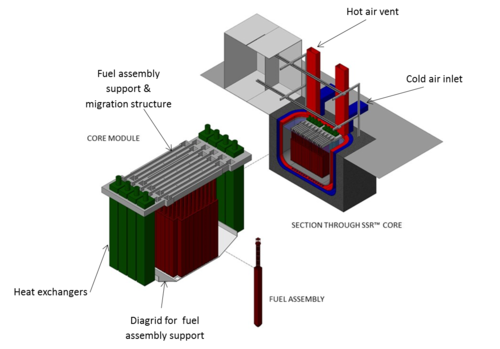Moltex Energy LLP enlisted the help of Wilde’s CFD engineers to optimise the design of their revolutionary Stable Salt Reactor, created to generate a safer, cheaper and cleaner form of nuclear energy. A combination of spreadsheet-based fundamental calculation models and CFD simulations were used to characterise the heat transfer performance due to key parameters.

Company
Moltex Energy is a partnership between active philanthropic environmentalist John Durham, and scientist Ian Scott.
Bemused by how nuclear energy had gone from being ‘too cheap to meter’ to ‘too expensive to afford’, Ian became determined to remedy that flaw.
The result was his invention of the Stable Salt Reactor. The two met through the Weinberg Foundation, of which John Durham is a co-founder. John saw the enormous potential of the Stable Salt Reactor and formed a partnership with Ian, out of which Moltex Energy LLP was created.
Background
The Stable Salt Reactor is a new concept in the civil nuclear power industry. It is based on a simple but fundamental breakthrough, with the potential to result in an environmentally friendly, abundant source of power that can reduce dependence on fossil fuels.
Challenge
Moltex asked Wilde to help develop a more detailed understanding of the key parameters affecting heat transfer between the salt inside the fuel rods and the surrounding molten salts.
This would enable optimum reactor design, particularly focusing on the diameter and spacing of the rods. After demonstrating that overall heat transfer was limited by natural convection and conduction within the fuel salt, the key challenge was to maintain power output from the fuel rods whilst keeping the temperature of the molten salts below their boiling point.
Solution
Wilde’s CFD engineers first developed a spreadsheet-based calculation model to provide Moltex with a tool that aided fundamental decisions about reactor design variables. This also derived reasonable boundary conditions for more detailed CFD simulations, undertaken with ANSYS Fluent.
User-defined functions helped to successfully model heat generation within the fuel tubes and the temperature-dependent properties of the molten salts. The CFD simulations were used to optimise design by identifying maximum achievable reactor core power density.
Business Benefit
The practicality of achieving adequate heat transfer from molten salt nuclear fuel held in simple tubes is the central plank of Moltex Energy’s technology. It underpins the principal patent protecting the technology (which is now granted in the UK and pending worldwide), and the Wilde Analysis work was critical in achieving that patent protection.
This technology makes possible reactor innovations that can reduce the cost of nuclear-generated electricity by at least a factor of two, making it cost-competitive with burning coal. That economic advantage will allow rapid and extensive decarbonisation of the world’s power systems.
Wilde Analysis have been a pleasure to work with during this project, responsive to requests, delivering on time and at reasonable cost and providing good guidance as to optimal ways forward.